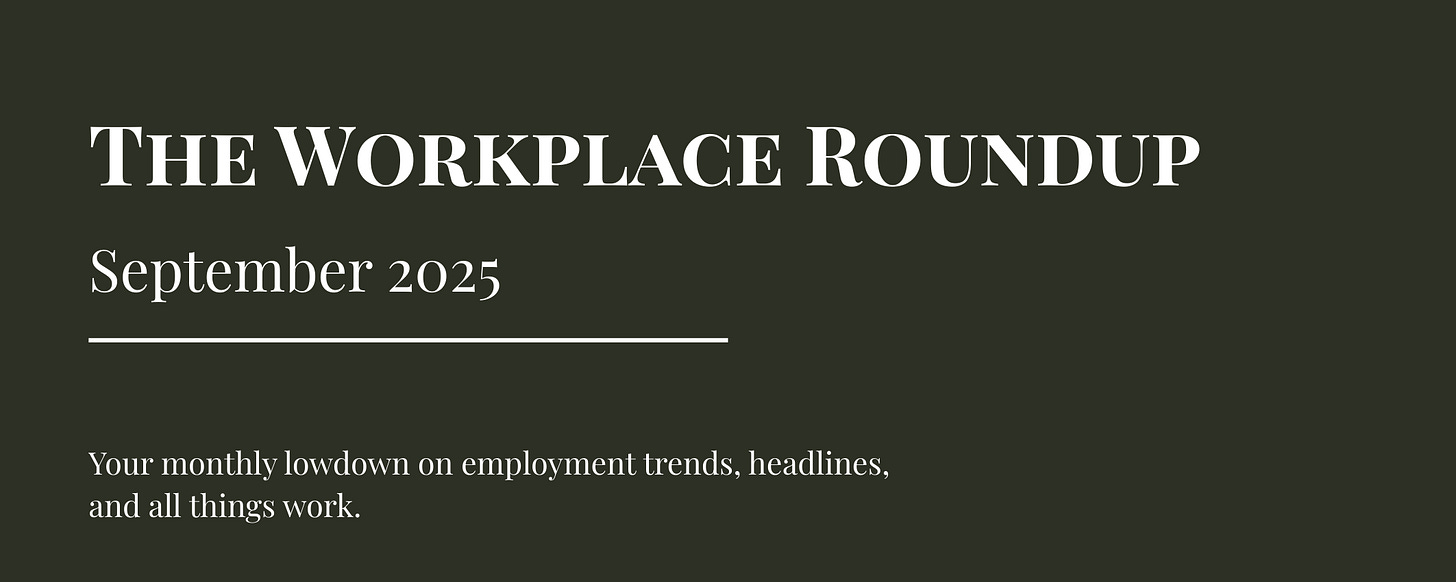The Workplace Roundup: September 2025
Job market is worse than we thought, employer costs are going up for healthcare benefits, and public firms may move to bi-annual reporting model.
US Workforce Trends 💼
911,000 Jobs “Disappeared” Over Night
In my last post, I discussed the lack of entry-level jobs available and the imbalance of there being more people unemployed than jobs available. Many job-seekers were aware of these challenges first hand. Updated job numbers for June and July were already revised, showing a weaker job economy than reported. Glad we weren’t crazy.
Well, turns out we really weren’t crazy, with this fresh set of revisions coming in. Once again, updated job numbers from the Bureau of Labor Statistics (BLS) show that things were worse than we thought and for even longer than we suspected. From March 2024-March 2025, payroll data shows a drop of 911,000 jobs from the initial estimate from the last year. These are the largest revisions seen since 2002.
911,000 jobs!! Gone. Never existed. For comparison, that’s basically the entire population of South Dakota, if everyone had a job, babies included.
Markdowns were greatest in hospitality, professional and business services, and retail trade, but most sectors saw downward revisions; except transportation and warehousing and utilities.
To get the job numbers, the BLS collects payroll data from companies and tracks business openings and closings. These surveys provide a sample, but they don’t capture the entire population. For the revised numbers, they compare their numbers with data from the Quarterly Census of Employment and Wages as well as tax data.
Has the BLS been gaslighting us the whole time, or are these honest mistakes? Either way, there are two main concerns here. 1) How healthy is the economy right now, actually? and 2) Why was the data so wrong?
I’ll dive into that soon. But for now, the BLS is definitely facing the heat for their data collection methods.
The Fed Cut Interest Rates by .25%
Because of the weakening job landscape, for the first time since December 2024, the Federal Reserve has lowered interest rates - by .25%, bringing the rate to 4-4.25%.
The Fed had delayed cutting interest rates because inflation remains above the 2% target, at 2.9% according to the CPI (measure of the price of goods and services compared to this time last year (not including housing fyi)). This time, they lowered rates to support a weakening job market, though concerns about inflation persist.
Since the 1970s, the Fed has used interest rates to balance inflation and employment, typically aiming for about 2% inflation and 5% unemployment. Lower interest rates are meant to boost lending and investment, which in turn should create more jobs.
Currently, unemployment is 4.3%, below the 5% mark. While this doesn’t quite meet the conditions for stagflation (a season of high inflation and unemployment), the worry comes from the number of job seekers exceeding available jobs. Hopefully, the lowered interest rates will incentivize employers to create more jobs like the Fed theorizes, but we won’t know until we see the numbers go up… and be revised again in a year.
If inflation continues to increase without jobs being created, things will get much more difficult.
Global Scope 🌍
France’s budget cuts to raise retirement age and scrap public holidays lead to public protests.
Unions have been taking to the streets in France this September over the governments new bill for budget cuts. These cuts were proposed to help the nations growing debt crisis, with public debt around 114% of its GDP. The proposal aimed to reduce public spending by €43-44 billion through raising the pension age (aka retirement age) from 62 to 64, scrapping two public holidays, and freezing certain levels of welfare and public spending. Critics argued these cuts would put the most burden on low- to middle-income workers and that it uproots many of the workers rights the French people have fought for and value.
How the bill was pushed through was why contentions rose. Now-former Prime Minister Francois Bayrou forced the budget bill through, bypassing a parliamentary vote (though technically legal through French law.) The current protests reflect opposition to the government’s approach to passing the bill, with the public deeming it as undemocratic. The controversy led to the ousting of the PM, with Sebastien Lecornu taking over as the successor. The full outcomes of these protests remain to be seen.
Work Wins, Woes, & Whoas
Work Wins 🏆
Blue-collar work is beginning to gain popularity among Gen Z, highlighted in the success story of 23-year old Jacob Palmer.
Jacob was a good student in high school, but after figuring out online college wasn’t for him, he decided to pursue becoming an electrician through a full-time apprenticeship. By the age of 21, he opened his own electrical business, grossing $90,000 by the end of his first year in business, 2024. Currently, his sales have exceeded last years.
With university tuition rising higher and higher, it’s important for today’s youth to consider other options outside of the traditional 4-year degree. Additionally, as the job market becomes slower, demand for services in the trades remain steady. AI can’t install electricity is houses yet!
Work Woes 📉
In 2026, it is expected that US companies’ spending on employee health care will grow by 10%. From 2024 to 2025, employee health-care plans already grew by 6.7%, from $14,865 to $15,860 per employee. The linked articles says the costs of prescription drug spending and the rise of chronic conditions are factors in these increased costs.
Health-care costs continue to outpace inflation rates. Because of this, employer-subsidized healthcare is one of the most important factors job-seekers look for in employment opportunities. With these rising costs, survey results from Mercer state that employers are more likely to raise employee cost-sharing amounts for health-care plans.
Work Whoas 🚨
I wrote previously on how companies focusing on quarter-over-quarter profits limits the incentives for them to focus on long-term, sustainable growth. Well, President Donald Trump is pushing the Securities and Exchange Commission (SEC) to move away from quarterly reporting requirements of public companies and toward a semi-annual reporting schedule. Since 1970, investors have relied on these regular reports for transparency into the on-goings of public firms and to determine how to invest and where. Moving to a semi-annual schedule could allow companies to focus on long-term strategies and invest more in their workforce (maybe even create more jobs?).
This would be a big change for the US stock market, but not one that other countries, like China or all EU members, haven’t already adopted. We’ll see whether the SEC adopts this model.
🔦Career Spotlight🔦
Industrial Machinery Mechanics
This role is projected to grow by 13-17% between 2024 and 2034. The manufacturing and logistics industry is one of the few industries experiencing continued growth in the US right now, and demand continues for new and skilled machinery maintenance workers. These mechanics are responsible for installing, replacing, and repairing machinery used in manufacturing. The work is very physically demanding, but as of 2024, the wages range from $63k-95k annually, with millwrights typically earning on the higher end.
Becoming an Industrial Machinery Mechanic: To get started, the minimum education required is a high school diploma or equivalent, and you’ll need to look for a position that offers on-the-job training. Some technical training may also be required in welding, hydraulics, computer diagnostics, or other areas depending on the position. To become a millwright, you will need to complete an apprenticeship, typically involving 3-5 years of training and hands-on experience.
(New!)Who’s Hiring 🔍
RK Industries - RK Industries announced major expansions in Colorado, projecting to create over 1,700 good-paying jobs over the next eight years.
HCA Healthcare / Parallon - HCA Healthcare, through their subsidiary Parallon, is hiring full-time Associates for permanent roles in multiples locations across the US and for remote roles.
Centene Corporation - Centene, a major health plans management company, has many job openings in states across the US.
HCL Technologies - This global consulting and IT services company has many open positions across the US as well as Brazil, Canada, and Mexico.
Personal Developments 🌱
🎧What I’m listening to: Wake Me Up When September Ends - Green Day. Anyone else feeling this? I don’t like to focus on only negative moves in the job market and general workforce, but things have been feeling especially heavy this September.
🍿 What I’m snacking on: GroundUp Nut Butters makes delicious nut butters while offering women overcoming adversity a second chance at employment through their 6–9 month training program that builds job skills and confidence. This not-just-for-profit model blends business success with community impact—proving profit and purpose can go hand in hand. Shop GroundUp Nut Butters
Reader Survey
In Case You Missed It ⤵️
Is the job market all an illusion?
The way I see it, we’re caught at the intersection of two difficult realities in today’s job market: genuine entry-level opportunities are becoming increasingly scarce, and for the first time since April 2021, the number of job-seekers has surpassed the number of available openings.
Labor activists didn't receive the death sentence just so you could buy a discounted mattress.
Squint hard enough through the haze of half-off mattress ads (how often are people buying mattresses anyway ?) and the smoke of over-charred hot dogs, and you might just catch it: Labor Day’s original spirit.








